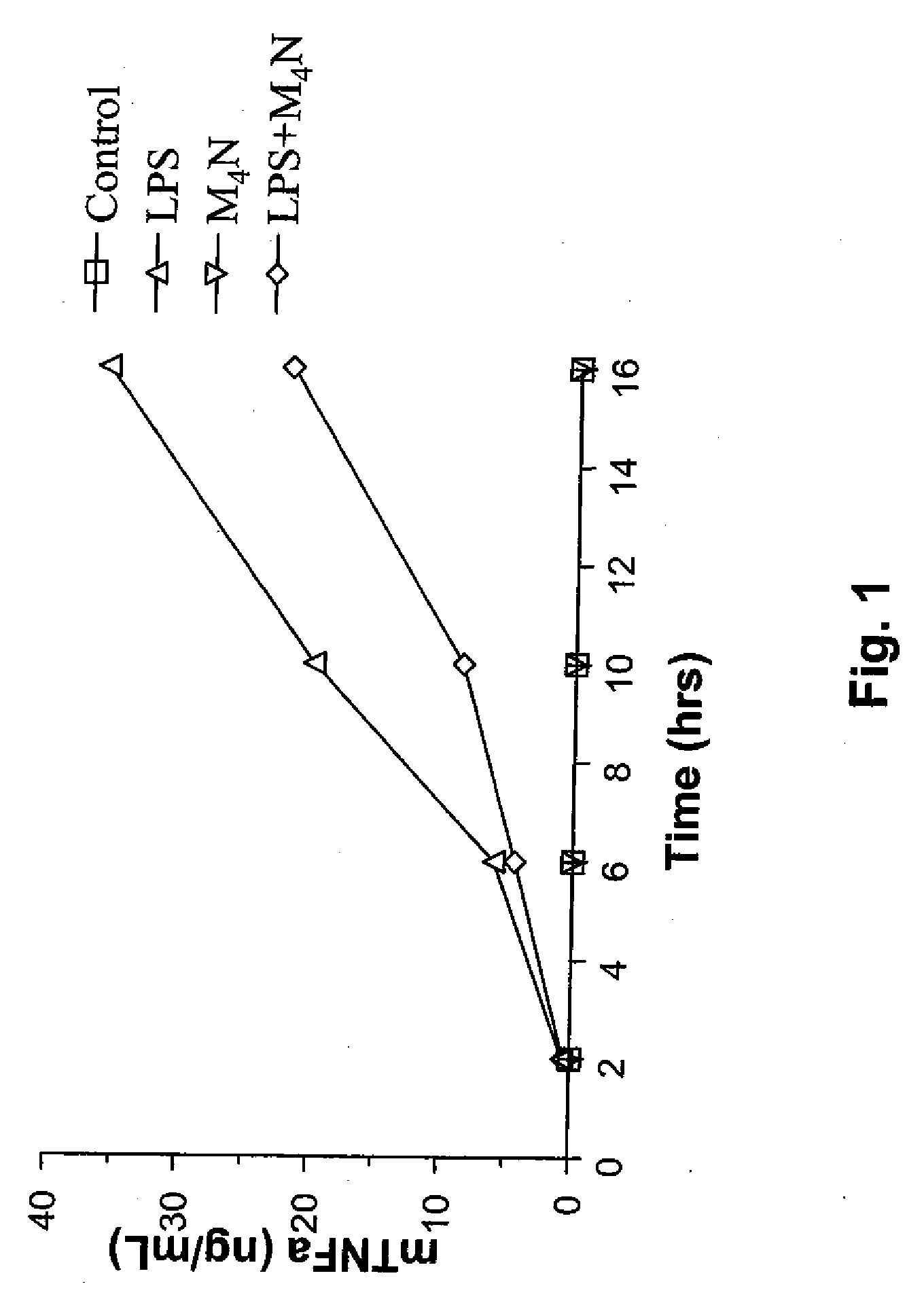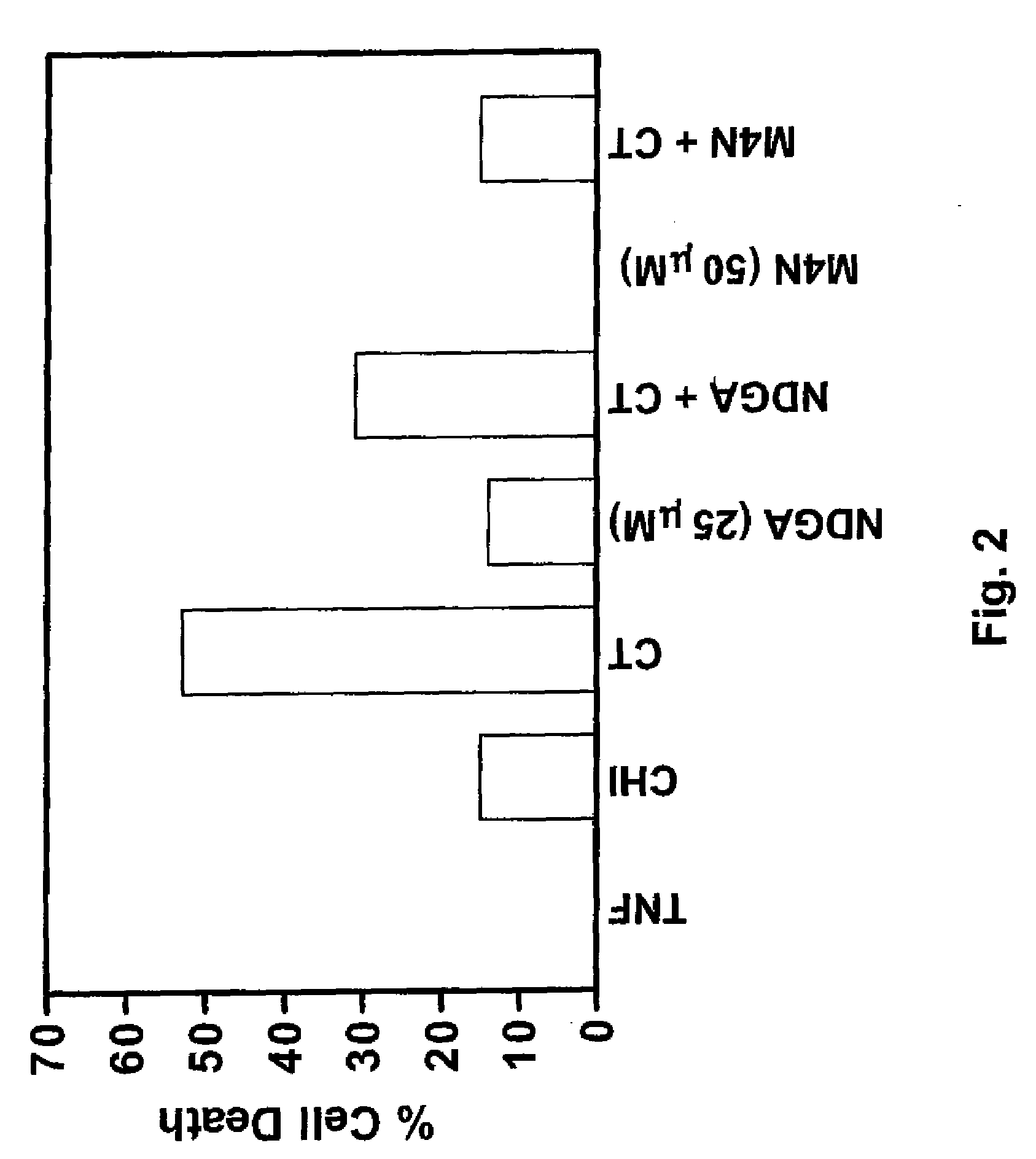Methods of treating influenza viral infections
a technology of influenza virus and treatment method, which is applied in the field of treatment methods of influenza viral infections, can solve the problems of inability of antiviral agents to cope with the mutations of influenza type a viruses, inability to fully satisfy antiviral agents, respiratory disorders and/or lethal pneumonia, etc., to inhibit the induction of tumor necrosis factor alpha, inhibit the induction of proinflammatory lipid mediators, and inhibit the induction of proinflammatory cytokine
- Summary
- Abstract
- Description
- Claims
- Application Information
AI Technical Summary
Benefits of technology
Problems solved by technology
Method used
Image
Examples
example 1
[0204]The effects of administering a catecholic butane of the general formula (I), namely M4N, on the production of TNF-α by LPS-stimulated RAW 264.7 macrophages were investigated to determine the ability of M4N to inhibit TNF-α induction. Methods similar to that of this Example can be used to determine the effect of any catecholic butane of the general formula (I) on the production of any proinflammatory cytokine in any LPS-stimulated macrophage cell.
[0205]As shown in FIG. 1 and explained below, M4N inhibits the LPS-induced TNF-α overexpression in RAW 264.7 macrophages with inhibition maximal at 57% at 10 hours post induction.
[0206]More specifically regarding the method used to determine the ability of M4N to inhibit TNF-α induction by LPS, 1.5×105 macrophages were either left untreated (control) or cultured for the indicated times with LPS (1 μg / ml), M4N (25 μM), or both compounds. RAW 264.7 cells are mouse monocyte macrophages. The LPS used was from Salmonella minnesota R595 and ...
example 2
[0210]The effects of administering a catecholic butane of the general formula (I), namely M4N, on TNF-α-induced apoptosis in murine fibroblasts were investigated to determine the ability of M4N to inhibit TNF-α-induced apoptosis. Methods similar to that of this Example can be used to determine the effect of any catecholic butane of the general formula (I) on TNF-α-induced apoptosis in any type of cells.
[0211]Influenza infection induces production of TNF-α, and TNF-α is well known for its pro-apoptotic activity. Influenza requires apoptosis for efficient replication and blocking TNF-α-induced apoptosis may reduce influenza replication and disease.
[0212]As shown in FIG. 2 and explained below, M4N strongly inhibits TNF-α-induced apoptosis in cells rendered sensitive to TNF by cycloheximide. C3HA murine fibroblasts were incubated with human recombinant TNF-α (20 ng / ml), cycloheximide (CHI) (10 μg / ml), or both, in the absence / presence of NDGA (25 μM) or M4N (50 μM). All compounds were ad...
example 3
[0215]The effects of administering a catecholic butane of the general formula (I), namely M4N, on the production of prostaglandin E2 (“PGE2”), prostaglandin F1α (“PGF1α”) and prostaglandin F2α (“PGF2α”), by LPS-induced RAW 264.7 macrophages were investigated to determine the ability of M4N to inhibit over production of prostaglandins in response to influenza viral infection. Methods similar to that of this Example can be used to determine the effect of any catecholic butane of the general formula (I) on the production of any pro-inflammatory lipid mediator in any LPS-stimulated macrophage cell.
[0216]Prostaglandins are autocrine and paracrine lipid mediators found in virtually all tissues and organs. They are synthesized in the cell from the essential fatty acids, such as the gamma-linolenic acid, arachidonic acid, and eicosapentaenoic acid. They act upon a variety of cells, such as platelet cells causing aggregation or disaggregation, vascular smooth muscle cells causing constrictio...
PUM
| Property | Measurement | Unit |
|---|---|---|
| body weight | aaaaa | aaaaa |
| temperature | aaaaa | aaaaa |
| temperature | aaaaa | aaaaa |
Abstract
Description
Claims
Application Information
 Login to View More
Login to View More - R&D
- Intellectual Property
- Life Sciences
- Materials
- Tech Scout
- Unparalleled Data Quality
- Higher Quality Content
- 60% Fewer Hallucinations
Browse by: Latest US Patents, China's latest patents, Technical Efficacy Thesaurus, Application Domain, Technology Topic, Popular Technical Reports.
© 2025 PatSnap. All rights reserved.Legal|Privacy policy|Modern Slavery Act Transparency Statement|Sitemap|About US| Contact US: help@patsnap.com



